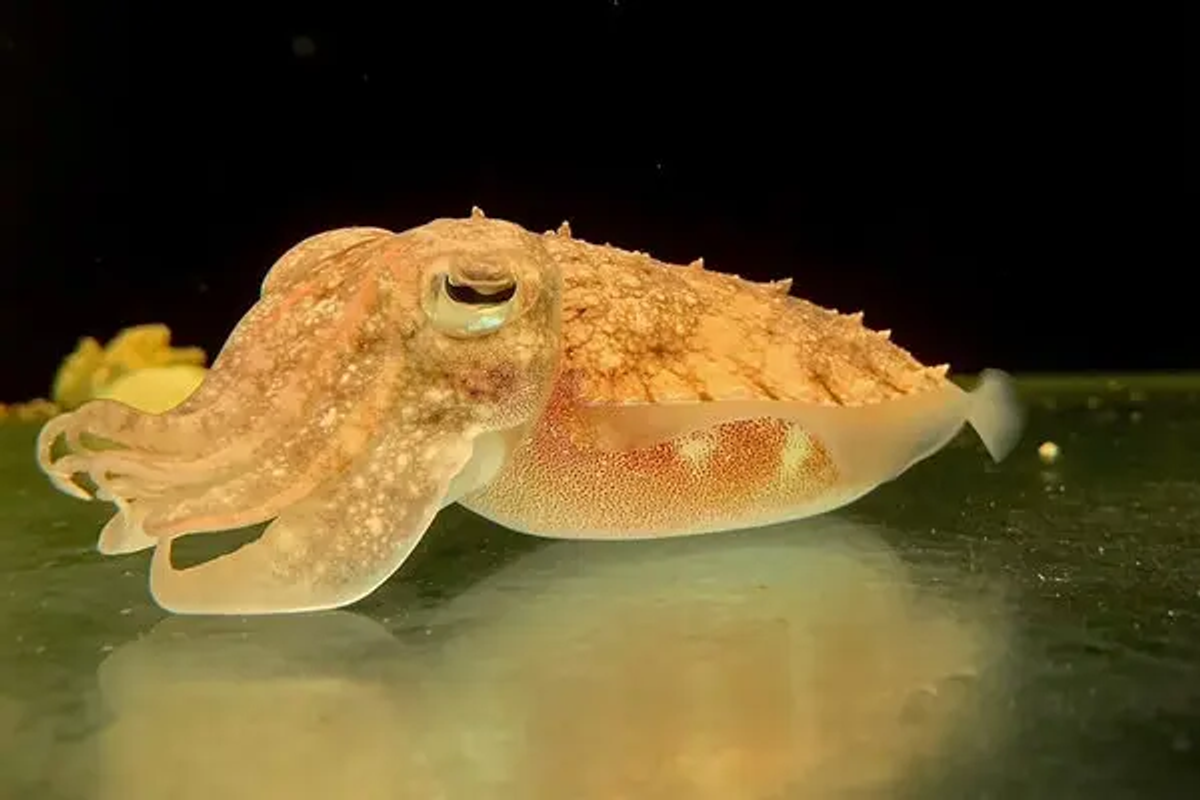The Cephalopod Page:

Cuttlefish Took Something Like a Marshmallow Test. Many Passed.
Zipping through water like shimmering arrowheads, cuttlefish are swift, sure hunters — death on eight limbs and two waving tentacles for small creatures in their vicinity.
They morph to match the landscape, shifting between a variety of hues and even textures, using tiny structures that expand and contract beneath their skin. They even seem to have depth perception, researchers using tiny 3-D vision glasses found, placing them apart from octopuses and squids. And their accuracy at striking prey is remarkable.
But for cuttlefish, these physical feats in pursuit of food are not the whole story. A new study published this month in the journal Royal Society Open Science shows that there is even more to cuttlefish cognition than scientists may have known.
The sea creatures appear to be capable of performing calculations that are more complicated than simply “more food is better.” Presented with a choice between one shrimp or two, they will actually choose the single shrimp when they have learned through experience that they are rewarded for this choice.
While the braininess of their octopus cousins gets a lot of attention, researchers who study animal cognition have uncovered surprising talents in cuttlefish over the years. For instance, the cephalopods will hunt fewer crabs during the day if they learn that shrimp, their preferred food, is predictably available during the night. That shows that they can think ahead.
Chuan-Chin Chiao, a biologist at National Tsing Hua University in Taiwan, and an author of the current paper alongside his colleague Tzu-Hsin Kuo, has found in the past that cuttlefish that are hungry will choose a bigger, harder-to-catch shrimp to attack, and those that are not will choose smaller, easier-to-catch ones.
But researchers have also found that animals do not always make decisions that seem logical at first glance. Like humans, whose behavior rarely fits economists’ visions of what an ideal, rational creature would do, animals respond to their environments using learned experiences.
In these new experiments, curious to see whether they could alter the value cuttlefish attach to a single shrimp, the researchers gave the cuttlefish the option of entering a chamber with one shrimp or a chamber with none. Each time they entered the chamber with a shrimp, the researchers gave them a smaller shrimp as a reward.
Then each cuttlefish took a second test. They could enter a chamber and chase after two shrimp. Or they could enter another chamber that had only one. “You’d think they always choose the larger quantity,” Dr. Chiao said. But that was not what happened. In the second round the cuttlefish chose one shrimp significantly more often than two.
Cuttlefish that hadn’t had the training reliably picked two shrimp over one, demonstrating that those that chose the smaller number were anticipating the reward and operating differently than their fellows. Even waiting until an hour had passed since the initial training did not completely erase the new behavior.
The process of being rewarded for choosing one shrimp seems to have given that option an extra glow as far as cuttlefish are concerned, Dr. Chiao said. That suggests that they are not simply making basic responses to prey they come across — they’re remembering what has come before and using it to make a choice. Even if in this situation the behavior didn’t result in a bigger haul, it adds to the evidence that they are complex creatures, capable of using their brains in ways that may surprise us.
Ten Interesting Facts About Cuttlefish:
1. Cuttlefish have not one, not two, but three hearts!
Two hearts are used to pump blood to the cuttlefish’s large gills, and the third heart is used to circulate oxygenated blood to the rest of the body.
2. Cuttlefish have truly impressive vision
Cuttlefish can see what’s behind them. It can see well in low light and can also detect polarized light, enhancing its perception of contrast. The cuttlefish moves its lenses by reshaping its entire eye. Also, the cuttlefish’s eyes are very large in proportion to its body and may increase image magnification upon the retina, while the distinct ‘W’-shaped pupil helps control the intensity of light entering the eye.”
3. Chameleons of the sea
Cuttlefish are referred to as the “chameleons of the sea” due to their color-changing abilities. They can do this even though they are completely color blind. They can even successfully change color to match their surroundings in complete darkness. Cuttlefish are cephalopods, which means they are in the same class as octopus who are also great at camouflage.
4. There Are Over 100 Species of Cuttlefish
There are over 100 species of cuttlefish. These animals vary in size from a few inches to several feet in length. The giant cuttlefish is the largest cuttlefish species and can grow to 50cm in length and more than 10kgs in weight.
5. Cuttlefish Have Eight Arms and Two Tentacles
The cuttlefish has two long tentacles that are used to quickly grasp its prey, which it then manipulates using its arms. Both the tentacles and arms have suckers.
6. Cuttlefish Have a Short Lifespan
Cuttlefish mate and lay eggs in spring and summer. Males may put on an elaborate display to attract a female. Mating occurs with the male transferring a sperm mass to the female’s mantle, where it is released to fertilize the eggs. The female attaches groups of egg onto objects (e.g., rocks, seaweed) on the seafloor. The female stays with the eggs until they hatch, but both the male and female die shortly afterward. Cuttlefish are sexually mature at 14 to 18 months of age and only live 1 to 2 years.
7. Cuttlefish Propel Themselves With Fins and Water
Cuttlefish have a fin that goes around their body, which looks like a skirt. They use this fin for swimming. When quick movement is needed, they can expel water and move by jet-propulsion.
8. They Use A Cuttlebone to Regulate Buoyancy
Within their bodies, cuttlefish have a long, oval bone called a cuttlebone. This bone is used to regulate buoyancy using chambers that may be filled with gas and/or water depending on where the cuttlefish is in the water column. Cuttlebones from dead cuttlefish may wash up on shore and are sold in pet stores as a calcium/mineral supplement for domestic birds.
9. Cuttlefish May Release Ink
When threatened, cuttlefish may release an ink called sepia in a cloud that confuses predators and allows the cuttlefish to get away. This ink historically was used for writing and drawing, can be used to treat medical conditions and is also used as a food coloring.
10. Cuttlefish Can See Light Invisible to Humans
Cuttlefish can’t see color, but they can see polarized light, an adaptation which may aid in their ability to sense contrast and determine what colors and patterns to use when blending into their surroundings. The pupils of cuttlefish are W-shaped and help control the intensity of light entering the eye. To focus on an object, a cuttlefish changes the shape of its eye, rather than the shape of its eye’s lens, as we do.
To Finish - A Glass Octopus Below:


